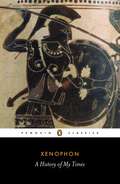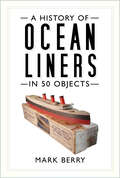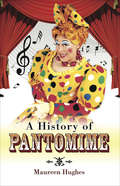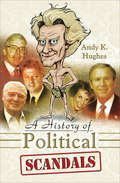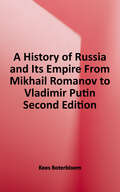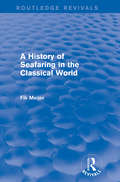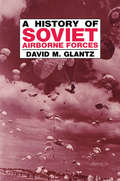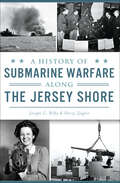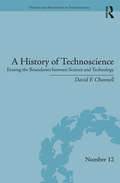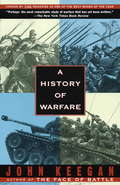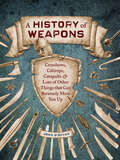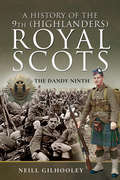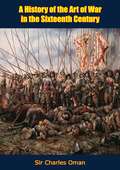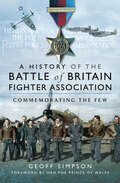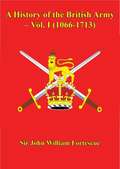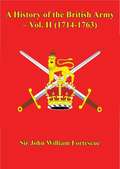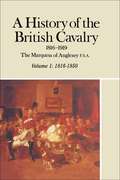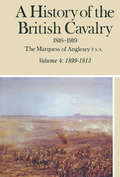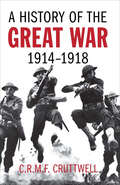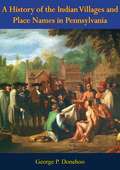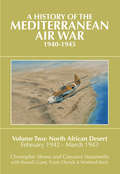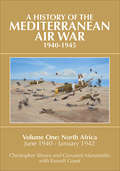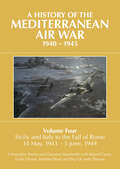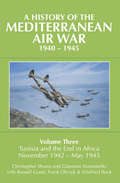- Table View
- List View
A History of My Times
by XenophonXenophon's History recounts nearly fifty turbulent years of warfare in Greece between 411 and 362 BC. Continuing the story of the Peloponnesian War at the point where Thucydides finished his magisterial history, this is a fascinating chronicle of the conflicts that ultimately led to the decline of Greece, and the wars with both Thebes and the might of Persia. An Athenian by birth, Xenophon became a firm supporter of the Spartan cause, and fought against the Athenians in the battle of Coronea. Combining history and memoir, this is a brilliant account of the triumphs and failures of city-states, and a portrait of Greece at a time of crisis.
A History of Ocean Liners in 50 Objects
by Mark BerryExplore the history of ocean liners through the objects that bring them to life.Liners represented the ambitions of their nations in peace and war; their design, interiors and fittings incorporated the finest contemporary technological and artistic features. In peacetime they carried celebrities, vacationers and emigrants; while in war they carried thousands of troops – and then war brides seeking new lives.A History of Ocean Liners in 50 Objects takes in evolving technology, supreme luxury and fine cuisine, as well as hardship and the burning hope for a better life. There is peril, disaster and death, international pride and competition, glory and war. The objects tell a fascinating story, showing how the functional sea voyage has evolved from the late nineteenth and early twentieth century to the huge cruise industry we have today.
A History of Pantomime
by Maureen HughesEach Christmas entire families in the UK troop off to see, what one could almost say is 'the obligatory'. annual entertainment, known as Pantomime. It is a traditional, seasonal way of life for the British envied the world over, and one which only the British seem to understand! Pantomime serves both to entertain and to introduce each new generation to the joys of theatre in the most unique of ways, for this is not a type of theatre one merely watches, but one in which the audience participate often in the most seemingly boisterous and bizarre of ways. The whole experience is steeped in tradition, traditions which only the British seem to understand, which is probably why we are proud to call it a 'British Experience.'In A History of Pantomime Maureen Hughes takes a brief look at the history of Pantomime as well as taking a humorous look at some of the above mentioned traditions; she also gives a synopsis of each of the well-known Pantomimes whilst exploring the eccentric world of the characters who appear in them. There is also a short piece on just some of the most well-known and loved of the actors who each Christmas take on the part of Pantomime Dames across the UK, as well as a look at others who have contributed to this magical world of fun and eccentricity. It is thought by some to be frivolous and pointless piece of theatre, but a browse through this informative book and you will soon find that Pantomime is an art form all of its own, requiring the most dedicated and talented of actors/actresses who are prepared to honour and perpetuate this wonderful tradition as it is passed down from one generation to the next.As seen in The Telegraph and the Sunday Post (Glasgow).
A History of Political Scandals: Sex, Sleaze And Spin
by Andy K. HughesA must-have guide to the scandalous behavior of politicians around the world. Andy Hughes&’s fascinating book guides us through centuries of political abuse—and just plain stupidity. This pocket guide exposes the secret side of politics, including politicians who risked or ruined their own careers for personal gain. Stories include the MP who liked to party hard and be whipped even harder; the prime minister and his hookers; expenses claims for manure; and the US president who called for all gay men to be castrated. Politicians have mixed scandal with eggs, adult movies, helicopters, drugs, shoes, beef burgers, public toilets, mobile phones, rape, turkeys, orgies, and even ice cream. And it&’s not just today&’s politicians who are embroiled with scandal. This explosive book reveals the questionable behavior of politicians of yesteryear from around the world.
A History of Russia and its Empire: From Mikhail Romanov to Vladimir Putin
by Kees BoterbloemThis clear and focused text provides an introduction to imperial Russian and Soviet history from the crowning of Mikhail Romanov in 1613 to Vladimir Putin's new term. Through a consistent chronological narrative, Kees Boterbloem considers the political, military, economic, social, religious, and cultural developments and crucial turning points that led Russia from an exotic backwater to superpower stature in the twentieth century. The author assesses the tremendous price paid by those who made Russia and the Soviet Union into such a hegemonic power, both locally and globally. He considers the complex and varied interactions between Russians and non-Russians and investigates the reasons for the remarkable longevity of this last of the colonial powers, whose dependencies were not granted independence until 1991. He explores the ongoing legacies of this fraught decolonization process on the Russian Federation itself and on the other states that succeeded the Soviet Union. The only text designed and written specifically for a one-semester course on this four-hundred-year period, it will appeal to all readers interested in learning more about the history of the people who have inhabited one-sixth of the earth's landmass for centuries.
A History of Seafaring in the Classical World (Routledge Revivals)
by Fik MeijerA History of Seafaring in the Classical World, first published in 1986, presents a complete treatment of all aspects of the maritime history of the Classical world, designed for the use of students as well as scholars. Beginning with Crete and Mycenae in the third millennium BC, the author expounds a concise history of seafaring up to the sixth century AD. The development of ship design and of the different types of ship, the varied purposes of shipping, and the status and conditions of sailors are all discussed. Many of the most important sea battles are investigated, and the book is illustrated with a number of line drawings and photographs. Greek and Latin word are only used if they are technical terms, ensuring A History of Seafaring in the Classical World is accessible to students of ancient history who are not familiar with the Classical languages.
A History of Soviet Airborne Forces (Soviet (Russian) Military Theory and Practice)
by David M. GlantzFor almost 70 years Soviet and Russian military theorists have been fascinated with the concept of airborne operations. Now Russian theorists tackle the problems posed to such operations by high-precision weaponry. This work, using newly released and formerly classified Soviet and East German archives, provides a detailed record of the performance of Soviet airborne forces during peace and war.
A History of Submarine Warfare Along the Jersey Shore (Military)
by Harry Ziegler Joseph G. BillyThe ingenious people of the Garden State were instrumental in the early development of the submarine. The first American submarine sank off Fort Lee in 1776, and the first successful one adopted by the U.S. Navy was invented by Paterson's John Holland at the end of the nineteenth century. Those early vessels were tested in the Passaic River and on the Jersey City waterfront. Today, the only surviving Union Civil War submarine, built in Newark, sits in the National Guard Militia Museum in Sea Girt. In 1918, the technology pioneered there was turned against the Jersey Shore when U-151 went on a one-day ship-sinking rampage. A World War II U-boat offensive torpedoed numerous ships off the coast, leaving oil-soaked beaches strewn with wreckage. Authors Joseph G. Bilby and Harry Ziegler reveal the remarkable history of submarines off the New Jersey coastline.
A History of Technoscience: Erasing the Boundaries between Science and Technology (History and Philosophy of Technoscience)
by David F. ChannellAre science and technology independent of one another? Is technology dependent upon science, and if so, how is it dependent? Is science dependent upon technology, and if so how is it dependent? Or, are science and technology becoming so interdependent that the line dividing them has become totally erased? This book charts the history of technoscience from the late nineteenth century to the end of the twentieth century and shows how the military–industrial–academic complex and big science combined to create new examples of technoscience in such areas as the nuclear arms race, the space race, the digital age, and the new worlds of nanotechnology and biotechnology.
A History of Warfare
by John KeeganThe acclaimed author of The Face of Battle examines centures of conflict in a variety of diverse societies and cultures. "Keegan is at once the most readable and the most original of living military historians . . . A History of Warfare is perhaps the most remarkable study of warfare that has yet been written."--The New York Times Book Review.
A History of Weapons: Crossbows, Caltrops, Catapults & Lots of Other Things that Can Seriously Mess You Up
by John O'Bryan“[A] menacingly illustrated book . . . nerdily gushes over the design and use of 130+ historical instruments of combat.” —ThrillistOne day a prehistoric guy picked up a rock and threw it at something. And the history of weapons began. Comedy writer and weapon nerd John O’Bryan relays the freaky highlights of man’s centuries-old obsession with weaponry. He hilariously explains the mace, the morning star, and the man catcher, while conveying factual information about each weapon: its history, uses, and badass potential. Looking through history’s highlights, readers will learn about Attila the Hun, Genghis Khan, and the “peaceful” Shaolin monks. This ultimate compendium of awesome weapons delivers all the surprisingly true details sure to impress anybody who’s ever made a gun with their fingers and said, “PEW-PEW-PEW!”“[A] comic breakdown of weaponry.” —Lost in a Supermarket
A History of the 9th: The Dandy Ninth (Pals Ser.)
by Neill GilhooleyThis regimental history chronicles the Dandy Ninth Battalion Royal Scots from its first forays in the Boer War through the brutal fighting of WWI.After suffering the disastrous Black Week of the Second Boer War, the British Army formed a new Highland battalion, the kilted 9th Royal Scots, which became affectionately known as the Dandy Ninth. It sent volunteers to South Africa and established itself as Edinburgh’s kilted battalion, part of the Territorial Force of part-time soldiers.Mobilized in 1914 as part of the Lothian Brigade, the Dandy Ninth defended Edinburgh from the threat of invasion, and constructed part of the landward defenses around Liberton Tower. They were part-time soldiers and new recruits, drawn from the breadth of society, from lawyers to rugby players and artists, such as the Scottish Colorist F.C.B. Cadell, and William Geissler of the Edinburgh School.In the Great War they mobilized to France and Flanders and served in many of the major actions: in Ypres and on the Somme; at Arras and Cambrai in 1917; and during the 1918 German Spring Offensive at St Quentin. In the Advance to Victory, they were with the 15th (Scottish) Division.
A History of the Art of War in the Sixteenth Century: A History Of The Art Of War In The Sixteenth Century (1937) (Routledge Revivals)
by Charles OmanTHE BEST ACCOUNT OF SIXTEENTH-CENTURY WARFARE BY THE AUTHOR OF A HISTORY OF THE PENINSULAR WARThis is an unrivalled account of sixteenth-century warfare, in which Sir Charles Oman traces the dramatic, far-reaching changes in the military strategy, tactics and organization of the period.Showing how warfare developed, he covers the Great Wars of 1949-1559; military events in Tudor England, including Henry VIII’s continental wars; the French Wars of Religion, 1562-98; the Dutch revolt and war of independence, 1568-1603; and the Turkish offensive against Christendom, from 1520 until the Peace of Sitva Torok in 1606.The battles, sieges and campaigns that Oman examines in detail clarify military development across the century, such as Ravenna (1512), the first battle won by dominance in artillery; Pavia (1525), a ‘victory by surprise’; Pinkie (1547), where an old-fashioned infantry army proved helpless against the combination of all arms; and Arques (1589), exemplifying the defence of a defile by very inferior number.Contemporary maps illustrate many of the actions, and add to the value of this brilliant and lucid history of the art of war.Sir Charles Oman was one of Britain’s foremost historians and a gifted writer. His books, noted for being both scholarly and accessible, include the two-volume History of the Art of War in the Middle Ages, the seven-volume A History of the Peninsular War and others.
A History of the Battle of Britain Fighter Association: Commemorating the Few (Battle of Britain)
by Geoff SimpsonIn 1945 it was announced that Allied airmen who had taken part in the Battle of Britain in 1940 would be entitled to the immediate award of the 1939-1945 Star, with Battle of Britain Clasp. This was the only Clasp awarded with the 1939-1945 Star.In the following years holders of the Clasp held informal get-togethers. In 1958 the Battle of Britain Fighter Association (BBFA) was formed, with full membership only available to holders of the Battle of Britain Clasp. Lord Dowding was the first President. Her Majesty Queen Elizabeth the Queen Mother became Patron. That post is now held by HRH The Prince of Wales.As well as organising reunions and providing some welfare assistance to members and widows, the Association has played a key role in researching entitlement to the Clasp and pronouncing on claims for the Clasp. A considerable part of the knowledge existing today on these matters came from the work of successive BBFA archivists, the late Group Captain Tom Gleave and the late Wing Commander John Young.The Association has also become closely associated with the Battle of Britain thanksgiving service held every September in Westminster Abbey.The Association's archives are held in part by the Secretary of the BBFA, Group Captain Patrick Tootal and in part by the Air Historical Branch, RAF (AHB) at RAF Northolt.Geoff Simpson has now been invited by the Association to use these archives as the basis of a book on the history of the organisation.
A History of the British Army – Vol. I (A History of the British Army #1)
by Sir John William FortescueSir John Fortescue holds a pre-eminent place amongst British military historians, his enduring fame and legacy resting mainly on his life's work "The History of the British Army", issued in 20 volumes, which took him some 30 years to complete. In scope and breadth it is such that no modern scholar has attempted to cover such a large and diverse subject in its entirety; but Sir John did so with aplomb, leading to a readable and comprehensive study.According to Professor Emeritus of Military History at King's College, Brian Bond, the work was "the product of indefatigable research in original documents, a determination to present a clear, accurate, and readable narrative of military operations, and a close personal knowledge of the battlefields, which enabled him to elucidate his account with excellent maps. Most important, however, was his motivation: namely, a lifelong affection for the old, long-service, pre-Cardwell army, the spirit of the regiments of which it largely consisted, and the value of its traditions to the nation. An important part of his task was to distil and inculcate these soldierly virtues which, in his conservative view, contrasted sharply with the unedifying character of politicians who habitually meddled in military matters." ODNB.This first volume covers the period from the battle of Hastings in 1066 to the end of the Seven Year's War in 1713. It includes the battles at Bannockburn, Crecy, Agincourt, Flodden, the battles of the English Civil War, Dunkirk Dunes, Tangiers, and the battles during Marlborough's campaigns. The volume also traces the development of European Armies, infantry, cavalry and artillery, and the specific changes in Britain during the period.A MUST READ for any military enthusiast.Author -- Fortescue, J. W. Sir, 1859-1933.Text taken, whole and complete, from the second edition published in 1910, London, by Macmillan and Co.Original Page Count - XXXV and 593 pages.Illustrations -- Numerous.
A History of the British Army – Vol. II (A History of the British Army #2)
by Sir John William FortescueSir John Fortescue holds a pre-eminent place amongst British military historians, his enduring fame and legacy resting mainly on his life's work "The History of the British Army", issued in 20 volumes, which took him some 30 years to complete. In scope and breadth it is such that no modern scholar has attempted to cover such a large and diverse subject in its entirety; but Sir John did so and with aplomb, leading to a readable and comprehensive study.According to Professor Emeritus of Military History at King's College, Brian Bond, the work was "the product of indefatigable research in original documents, a determination to present a clear, accurate, and readable narrative of military operations, and a close personal knowledge of the battlefields, which enabled him to elucidate his account with excellent maps. Most important, however, was his motivation: namely, a lifelong affection for the old, long-service, pre-Cardwell army, the spirit of the regiments of which it largely consisted, and the value of its traditions to the nation. An important part of his task was to distil and inculcate these soldierly virtues which, in his conservative view, contrasted sharply with the unedifying character of politicians who habitually meddled in military matters." ODNB.This second volume covers the period from 1713 to 1763, including the Jacobite rebellion of 1715, the wars of Austrian Succession, and British expansion into America and India and the enduring struggle with France for Imperial power.A MUST READ for any military enthusiast.Author -- Fortescue, J. W. Sir, 1859-1933.Text taken, whole and complete, from the second edition published in 1910, London, by Macmillan and Co.Original Page Count - xxii and 606 pages.Illustrations -- Numerous maps and plans
A History of the British Cavalry, 1816–1850 Volume 1: 1816–1919
by The Marquess of AngleseyIn-depth coverage of the Charge of the Light Brigade, and the numerous colonial campaigns of the period.
A History of the British Cavalry, 1899–1913 Volume 4: 1816–1919
by The Marquess of AngleseyIn the seventh, and second last, volume in t his historical work, Lord Anglesey shows how superior the Br itish cavalry was compared to those of the French and German s. He concentrates on the first five months of the War. '
A History of the English-Speaking Peoples, Volume III: The Age of Revolution
by Winston ChurchillEnglish history from 1688 to 1815. This period includes the English, French, and American revolutions, all of which had enormous impact on world development.
A History of the Great War, 1914–1918: 1914-1918
by C.R.M.F. CruttwellThis vivid, detailed history of World War I presents the general reader with an accurate and readable account of the campaigns and battles, along with brilliant portraits of the leaders and generals of all countries involved. Scrupulously fair, praising and blaming friend and enemy as circumstances demand, this has become established as the classic account of the first world-wide war.
A History of the Indian Villages and Place Names in Pennsylvania
by George P. DonehooNo state in the entire Nation is richer in Indian names, or in fact, in Indian history than Pennsylvania. These Indian names of Pennsylvania are full of music, but, of far greater importance, they are full of history. A History of the Indian Villages and Place Names in Pennsylvania, which was first published in 1928, is the only major book of the 20th century that traces Pennsylvania’s Indian place and names for their correct form, origin and history. Its pages are filled with the most incredible collection of information ever assembled on the Indian villages of Pennsylvania and their Indian place names and is an Indian history scholar’s delight.In preparing his book, Dr. Donehoo researched every available source of printed material about Indian place names in Pennsylvania. He also walked nearly every Indian trail, from the Delaware to the Ohio, using early trader’s journals and maps as his guide, to seek out the places the Indians lived. Each Indian name comes complete with historical notes by the author. The book includes a list of all the sources used to authenticate each Indian place name. An excellent bibliography follows at the conclusion of the work along with appendixes listing: the Indian villages of New York destroyed by General Sullivan’s army in 1779, prehistoric works in Pennsylvania by county, and an alphabetical listing of all Indian named places in each county.
A History of the Mediterranean Air War, 1940–1945. Volume 2: North African Desert, February 1942–March 1943
by Christopher Shores Giovanni Massimello Russell Guest Frank Olynyk Winfried BockThis second volume in the seminal series on aerial combat, pilots, and tactics in Libya and Egypt in the middle of World War II. In volume two of this series, historian Christopher Shores begins by exploring the 8th Army&’s movements after Operation Crusader when they were forced back to the Gazala area in northeastern Libya, as well as their defeat in June, 1942, the loss of Tobruk, and the efforts of Allied air forces to protect their retreating troops. Shores continues with the heavy fighting that followed in the El Alamein region. This features the Western Desert Air Force and the arrival of the first Spitfires. The buildup of both army and air forces and the addition of new commanders on the ground aided the defeat of Rommel&’s Deutsche Afrika Korps at Alam el Halfa, after which came the Second Battle of El Alamein. With the arrival of the United States Army Air Force, the Allied air forces gained dominance over the Axis. Shores recounts the lengthy pursuit of the Italo-German forces right across Libya, including the capture of Tripoli and the breakthrough into Southern Tunisia. This allowed a linkup with other Allied forces in Tunisia (whose story appears in Volume 3). Included with the action are stories of some of the great fighter aces of the Desert campaign such as Jochen Marseille and Otto Schulz of the Luftwaffe, Franco Bordoni-Bisleri of the Regia Aeronautica and Neville Duke, Billy Drake, and &“Eddie&” Edwards of the Commonwealth air forces. Finally, Shores touches on the Allied and Axis night bombing offensives and the activities of the squadrons cooperating with the naval forces in the Mediterranean.
A History of the Mediterranean Air War, 1940–1945: North Africa
by Christopher Shores Giovanni Massimello Russell GuestThis first volume in the seminal series on World War II aerial combat, pilots, and tactics that “reads like an encyclopedia on the subject” (Portland Book Review). In the early days of World War II, both Allied and Axis powers extended the theater of war to North Africa, where hard-fought battles were conducted in the harsh desert. But before anyone could claim victory on the ground, they had to hold dominion in the air. Here, historian Christopher Shores has combined his books Fighters over the Desert and Fighters over Tunisia into one volume, as well as adding updated information about the deadly fighter aircraft, reconnaissance aircraft, and maritime units active in the Mediterranean. Full of in-depth research and featuring essential maps, this is “an intimate introspection by these men of their experiences and the respect that they shared not only for each other but also their adversaries” (The Military Reviewer).
A History of the Mediterranean Air War, 1940–1945: Sicily and Italy to the Fall of Rome 14 May, 1943–5 June, 1944
by Christopher Shores Giovanni Massimello Russell Guest Frank Olynyk Winfried Bock Commander Andy ThomasThe fourth volume in this momentous series commences with the attacks on the Italian island fortress of Pantellaria which led to its surrender and occupation achieved almost by air attack alone. The account continues with the ultimately successful, but at times very hard fought, invasions of Sicily and southern Italy as burgeoning Allied air power, now with full US involvement, increasingly dominated the skies overhead. The successive occupations of Sardinia and Corsica are also covered in detail. This volume, then, is essentially the story of the tactical air forces up to the point when Rome was occupied, just at the same time as the Normandy landings were occurring in north-west France. In its pages are found what can justifiably be considered the story of ‘the soldiers’ air force’. Frequently overlooked by more immediate newsworthy events elsewhere, their struggle was often of an equally Homeric nature. With regards to the long-range tactical role of the Allied heavy bombers, only the period from May to October is examined herein, while they remained based in North Africa. Thus the period from November 1943 when the US 15th Air Force was formed to pursue the strategic air offensive against the Reich, together with the RAF’s 205 Group of night bombers, will be covered in a future (sixth) volume. Volume Five will deal with the rest of the tactical war in Italy and Greece, over the Adriatic and Aegean, and with the entry into the South of France to join forces advancing southwards from Normandy.
A History of the Mediterranean Air War, 1940–1945: Tunisia and the End in Africa, November 1942–1943 (A\history Of The Mediterranean Air War, 1940-1945 Ser. #2)
by Christopher Shores Giovanni Massimello Russell Guest Frank OlynykThe third volume in the epic military aviation series focuses on the Allied invasion of North Africa during World War II. This work of WWII history takes us to November 1942 to explain the background of the first major Anglo-American venture: Operation Torch, the invasion of French North Africa. Describing the fratricidal combat that followed the initial landings in Morocco and Algeria, it then considers the unsuccessful efforts to reach northern Tunisia before the Germans and Italians could get there to forestall the possibility of an attack from the west on the rear of the Afrika Korps forces, then beginning their retreat from El Alamein. The six months of hard fighting that followed, as the Allies built up the strength of their joint air forces and gradually wrested control of the skies from the Axis, are recounted in detail. The continuing story of the Western Desert Air Force is told, as it advanced from the east to join hands with the units in the west. Also covered are the arrivals over the front of American pilots and crew, the P-38 Lightning, the Spitfire IX, and the B-17 Flying Fortress—and of the much-feared Focke-Wulf Fw 190. The aerial activities over Tunisia became one of the focal turning points of World War II, yet are frequently overlooked by historians. Here, the air-sea activities, the reconnaissance flights, and the growing day and night bomber offensives are examined in detail.
